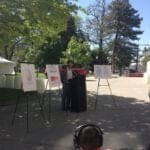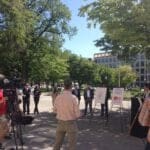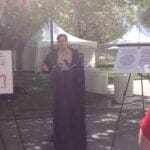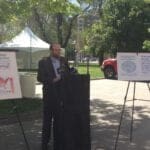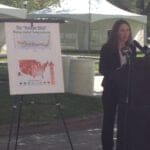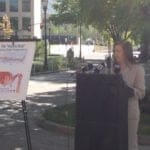 Salt Lake City Mayor Ralph Becker and Asheville Mayor Terry Bellamy have been selected as the nation’s top winners in the 2013 Mayors’ Climate Protection Awards, an initiative sponsored by The U.S. Conference of Mayors (USCM) and Walmart. Salt Lake City Mayor Ralph Becker and Asheville Mayor Terry Bellamy have been selected as the nation’s top winners in the 2013 Mayors’ Climate Protection Awards, an initiative sponsored by The U.S. Conference of Mayors (USCM) and Walmart.
The annual awards program, now in its seventh year, recognizes mayors for innovative practices that increase energy efficiency and reduce greenhouse gas emissions. An independent panel of judges selected the winners from a pool of applicants.
“Mayor Becker and Mayor Bellamy are great examples of the strong leadership at the local level working on climate protection,” said Philadelphia Mayor Michael A. Nutter, President of the U.S. Conference of Mayors. “As others debate these issues, mayors are acting on real climate solutions, showing how to curb both energy use and climate-harming emissions.”
“We are proud to honor these cities and their mayors, who remind all of us how their leadership is making a real difference in reducing greenhouse gas emissions and improving the quality of life in their communities,” said Greg Hall, Walmart’s Vice President of U.S. Sourcing and Manufacturing. “At the end of the day, these local efforts reduce our energy dependence and save money, results that help strengthen the U.S. economy.”
“In Salt Lake City, we are committed to doing what we can right now to address the climate change impacts that are already being felt at a local level and will only become more challenging,” said Salt Lake City Mayor Ralph Becker. “Setting goals for ourselves like constructing net-zero public facilities is one of the many things we can do as a community to mitigate and adapt to changes in our climate, helping to ensure a vibrant and sustainable future for our City.”
“The City of Asheville is honored to receive this award,” said Asheville Mayor Terry Bellamy. “By reinvesting our energy savings through our Green Capital Improvement Program, we are reducing air pollution in our region, making neighborhoods safer by installing high quality LED lights, and demonstrating fiscal responsibility by recycling tax dollars.”
“Mayors are leading the way on climate protection just like so many other issues before the nation,” said Conference of Mayors CEO and Executive Director Tom Cochran. “In their cities, we can see the innovation and imagination that leads to new strategies to combat the growing energy and climate challenges before us.”
First Place Winners
· Salt Lake City, UT Mayor Ralph Becker for the Net Zero Public Safety Building and Salt Lake Community Solar (Large City Category – population over 100,000)
The Salt Lake City Public Safety Building will be the first public safety building in the nation to achieve a Net Zero rating. To reach this lofty goal and ensure the building produces as much energy as it uses, the city employed a host of innovative technologies including rooftop solar and an off-site solar farm, planned LEED Platinum certification, locally-sourced and environmentally-sound materials and high efficiency mechanical systems. Its Salt Lake Community Solar (SLCS), a unique, market-driven approach to reducing the cost of solar energy using innovation and ingenuity to tackle the logistical and financial barriers of going solar, helps businesses and homeowners purchase and install solar energy systems.
· Asheville, NC Mayor Terry Bellamy for the Green Capital Improvement Program (Small City Category – population under 100,000)
The City of Asheville established a goal to cut carbon emissions in its municipal activities by 80 percent by 2030. In the five years following the adoption of this target, the city has achieved a 17.67% reduction in emissions, and it has also established a self-sustaining funding source that recycles energy savings to invest in additional sustainability programs. More recently, these energy savings and dollars are directed into the Green Capital Improvement Program (Green CIP) which funds the city ongoing initiatives to make further progress on its 80 percent reduction goal. During the worst financial crisis since the Great Depression, Asheville creatively reinvested energy savings to invest in improved greener services for its citizens.
In addition to the first place winners, Honorable Mentions were awarded to mayors in four large cities and six small cities for their exceptional achievements in efforts to promote climate protection:
Large City Honorable Mentions: Mayor Donald L. Plusquellic, Akron, OH, Mayor Gregory A. Ballard, Indianapolis, IN, Mayor Thomas Barrett, Milwaukee, WI, and Mayor Vincent C. Gray, Washington, DC
Small City Honorable Mentions: Mayor Kathleen J. DeRosa, Cathedral City, CA; Mayor Roy D. Buol, Dubuque, IA, Mayor Nancy R. Rotering, Highland Park, IL, Mayor Jerry Willey, Hillsboro, OR, J. Richard Gray, Lancaster, PA, and Mayor Chris Koos, Normal, IL.
Read the report (PDF):

|
|
 Following today’s announcement of the EPA’s new Clean Power Plan, which would set emissions standards for power plants, Salt Lake City Mayor Ralph Becker issued the following statement.
Following today’s announcement of the EPA’s new Clean Power Plan, which would set emissions standards for power plants, Salt Lake City Mayor Ralph Becker issued the following statement.
